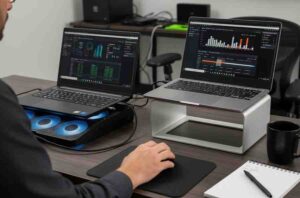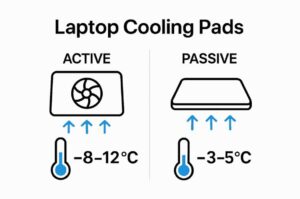Did you know that laptop temperatures rising above 80°C can cause significant performance drops and even damage your device? Overheating doesn’t just slow things down—it can shorten your laptop’s lifespan and lead to costly repairs.
As laptops work harder and run hotter, managing heat becomes critical for smooth performance and reliable hardware. Understanding how cooling solutions work helps you keep your device running strong and avoid unexpected breakdowns.
Table of Contents
Key Takeaways
| Point | Details |
|---|---|
| Thermal Management is Crucial | Managing laptop temperature is essential for performance and longevity, as overheating can lead to hardware damage and reduced lifespan. |
| Cooling Pads Enhance Performance | Utilizing cooling pads can significantly reduce internal temperatures, preventing thermal throttling during intensive tasks and improving overall performance. |
| Active vs. Passive Cooling | Active cooling pads with built-in fans provide more effective heat dissipation, while passive pads rely on natural airflow but may block vents in some designs. |
| Monitor and Maintain | Regularly check laptop temperature and maintain cooling pads for optimal performance, considering factors like fan size and positioning for best results. |
Table of Contents
Understanding Laptop Overheating Risks

Laptops generate substantial heat during intensive tasks, which can seriously compromise their performance and longevity. When internal temperatures surge beyond safe thresholds, your device enters a dangerous zone of potential hardware damage.
According to research from HP, laptop temperatures exceeding approximately 80°C trigger significant performance problems.
Thermal Throttling becomes a critical concern during high-stress computing scenarios. When your laptop’s temperature rises dramatically, the system automatically reduces CPU and GPU performance to prevent catastrophic damage. This means you’ll experience:
- Sudden lag and stuttering
- Unexpected frame rate drops
- Potential system instability
Lenovo’s research highlights an even more concerning long-term risk: accelerated component degradation. Continuous high temperatures don’t just impact immediate performance – they fundamentally shorten your laptop’s operational lifespan.
Consistent overheating increases hardware failure probability, potentially leading to costly repairs or complete device replacement.
The implications are clear: managing your laptop’s temperature isn’t just about smooth performance, but protecting your investment.
Proactive cooling strategies can mean the difference between a laptop that serves you reliably for years and one that fails prematurely. Read more about CPU temperature management to fully understand these critical thermal dynamics.
Types Of Laptop Cooling Pads Explained
Laptop cooling pads come in two primary design categories: active and passive. Each type offers unique thermal management strategies to help prevent overheating and protect your device’s performance. According to research from Wikipedia, understanding these variations can significantly impact your laptop’s cooling efficiency.
Active Cooling Pads
Active cooling pads are engineered with built-in fans that actively circulate air beneath your laptop. These sophisticated devices:
- Draw power directly through USB connections
- Feature multiple fan configurations
- Provide direct, targeted cooling
- Often include adjustable fan speeds
These pads work by creating additional airflow, helping to dissipate heat more effectively than standard laptop designs. They’re particularly beneficial for high-performance machines like gaming laptops or workstations with intensive processing requirements.
Passive Cooling Pads
Passive cooling pads take a different approach, utilizing conductive materials and strategic laptop elevation to improve natural airflow. However, users should exercise caution – these designs might inadvertently block essential underside vents on some laptop models.
Key characteristics of passive cooling pads include:
- No external power requirement
- Lightweight and portable
- Made from heat-absorbing materials like aluminum
- Use ergonomic design to create air gaps
For those seeking comprehensive cooling solutions, our guide to the best laptop cooling pads offers detailed insights into selecting the most effective cooling strategy for your specific device.

Here’s a comparison of active and passive laptop cooling pads:

| Feature | Active Cooling Pads | Passive Cooling Pads |
|---|---|---|
| Cooling Method | Built-in fans Active airflow | Heat-absorbing materials Elevation |
| Power Source | USB-powered | No external power |
| Typical Temp Reduction | 8–12°C | 3–5°C |
| Portability | Heavier Less portable | Lightweight Highly portable |
| Risk of Vent Blockage | Low (designed for airflow) | Possible on some models |
| Best For | Gaming laptops High performance | Portability Casual use |
How Cooling Pads Improve Laptop Performance
Cooling pads are more than just accessories – they’re critical performance enhancers for modern laptops. According to HP’s research guide, these devices play a crucial role in preventing thermal throttling during intense computing tasks by directing targeted airflow to dissipate heat effectively.
Temperature Reduction Mechanics
Research from performance testing reveals impressive cooling capabilities. Peplate’s comprehensive testing demonstrates remarkable temperature reduction:
- Active cooling pads: 8–12°C temperature drop
- Passive cooling pads: 3–5°C temperature reduction
These temperature decreases might seem small, but they significantly impact your laptop’s performance and longevity. By maintaining lower internal temperatures, cooling pads prevent your system from automatically reducing processing speed to avoid overheating.
Performance Benefits
The real-world advantages of using a cooling pad extend beyond temperature management. When your laptop maintains optimal thermal conditions, you’ll experience:
- Smoother frame rates during gaming
- Reduced system stuttering
- Consistent processing performance
- Extended hardware lifespan
For users with high-performance laptops, especially those working in intensive computing environments, investing in a quality cooling pad isn’t just recommended – it’s essential for protecting your technological investment.
Potential Drawbacks And Alternatives Compared
Cooling pads aren’t a universal solution for every laptop’s thermal management challenges. According to Wikipedia’s research, passive cooling pads can potentially create more problems than they solve, especially when they obstruct a laptop’s critical ventilation points.
Cooling Pad Limitations
Some cooling pad designs come with inherent drawbacks that users should carefully consider:
- Risk of blocking essential laptop vents
- Limited effectiveness on poorly designed internal cooling systems
- Potential reduction in laptop portability
- Additional accessory cost
Lenovo’s comprehensive guide suggests several alternative strategies for managing laptop temperatures when cooling pads aren’t ideal:
- Internal Cooling Optimization: Regularly clean laptop vents and fans
- Elevated Stands: Use sturdy stands that allow natural airflow
- Ambient Temperature Control: Maintain a cool working environment
- Thermal Paste Replacement: Periodically refresh thermal interface materials
Performance Considerations
While cooling pads can be beneficial, they’re not a magic solution. Your laptop’s internal thermal design plays a crucial role in determining cooling effectiveness.
For high-performance users, exploring specialized laptop options with robust built-in cooling might provide more consistent temperature management than relying solely on external cooling accessories.
Tips For Maximizing Cooling Pad Effectiveness
Laptop cooling optimization requires strategic selection and smart usage of your cooling pad. According to Lenovo’s comprehensive guide, choosing the right cooling pad involves considering several critical factors that directly impact thermal performance.
Selecting the Right Cooling Pad
When shopping for a cooling solution, prioritize these key characteristics:
- Large fans (120 mm or larger)
- Adjustable fan speed settings
- Mesh or aluminum surface for enhanced heat dissipation
- Lightweight and ergonomic design
- Precise laptop vent alignment
Performance Monitoring Strategies
HP’s gaming laptop cooling guide recommends using temperature monitoring tools to assess your cooling pad’s effectiveness. Professional users should:
- Install temperature tracking software like HWMonitor
- Measure baseline and cooled temperatures
- Check for consistent performance improvements
- Watch for warning signs such as:
- Unusual fan noise
- Unexpected frame rate drops
- System instability or unexpected crashes
Maintenance and Optimization
Maximizing your cooling pad’s performance isn’t a one-time setup. Regular maintenance and strategic positioning can significantly enhance thermal management.
For users seeking comprehensive cooling solutions, our guide to laptop performance offers additional insights into maintaining optimal computing temperatures.
Frequently Asked Questions
Why do laptops overheat, and how can cooling pads help?
Laptops can overheat due to intensive tasks, causing performance issues and potential hardware damage. Cooling pads enhance airflow, reducing temperatures and helping to prevent problems like thermal throttling.
What is the difference between active and passive cooling pads?
Active cooling pads have built-in fans to circulate air and provide targeted cooling. Passive cooling pads rely on materials to absorb heat and use elevation for airflow without fans. Each type has its benefits depending on your laptop’s needs.
How much temperature reduction can I expect from using a cooling pad?
Active cooling pads can reduce temperatures by 8–12°C, while passive pads typically lower temperatures by 3–5°C. Maintaining lower temperatures can significantly improve performance and extend your laptop’s lifespan.
Are there any drawbacks to using cooling pads?
Cooling pads can block essential vents on some laptops, may not be effective on poorly designed internal cooling systems, and can add weight. It’s essential to select a compatible cooling pad to avoid these issues.
Recommended
- 20 Best Laptop Cooling Pads To Prevent Overheating In 2025
- 15 Best Laptops For DJing: Reviews And Buying Guide, Pros, Cons, And Features In October 2025
- Complete Guide To PC Water Cooling: Build Your Dream Rig
- Understanding CPU Temperatures: What’s Safe And What’s Not



